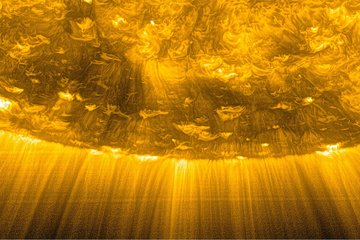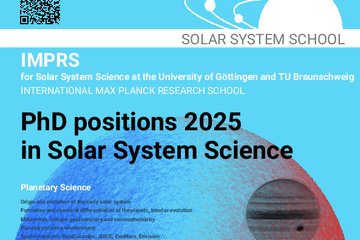Award for Excellent Publication
The publishing group Springer Nature has selected an MPS publication as the best in the journal Solar Physics in the past year.
The best scientific publication of the past year in the journal Solar Physics was submitted by a group of researchers led by the Max Planck Institute for Solar System Research (MPS) in Germany. The Kees de Jager Prize, with which the Springer Nature publishing group honors this achievement, was now presented to first author Dr. Gherardo Valori of the MPS at the annual general meeting of the International Union of Geodesy and Geophysics in Berlin. A division of IUGG also deals with solar magnetism. In their publication, the six-member research group shows how joint measurements from ESA's Solar Orbiter and NASA's Solar Dynamics Observatory (SDO) spacecraft can for the first time be used to unambiguously determine the orientation of the magnetic field at the solar surface from observations alone.

The Sun’s complex magnetic fields are considered the key to understanding our capricious star: they control its eleven-year activity cycle, trigger violent solar flares and eruptions and are the cause of the dark sunspots that cover the Sun in sometimes greater or lesser numbers. While near-Earth space probes and ground-based telescopes have been able to measure the magnetic field at the visible solar surface for decades, the orientation of the field component perpendicular to the direction of observation cannot be determined, and the knowledge of the magnetic field remains intrinsically incomplete.
A stereoscopic view of the Sun could be a remedy. Theoretically, observational data obtained from two observation sites can be combined in such a way as to reconstruct the strength and direction of all magnetic field components without doubt. Since its launch in 2020, ESA's Solar Orbiter has provided the unique opportunity to do this. Unlike other solar probes equipped with instruments for magnetic field observations, Solar Orbiter does not remain close to Earth, but orbits our star in highly elliptical orbits. Together with measurements from its near-Earth colleagues, such as NASA's Solar Dynamics Observatory, this opens up completely new possibilities. The team of authors has developed a corresponding method and presents it in the publication that has now been distinguished.
But as always, the devil is in the details. In practice, for example the specific angle between the observing telescopes and the resolution of the measurement data play a role. In a first step, the team of authors therefore simulated possible observational data and showed that even weak magnetic fields can be unambiguously determined with the new method for a large range of configurations of the two probes.
"The opportunity to look at the Sun together with SDO and thus obtain unique data sets has been one of the very special merits of the Solar Orbiter mission from the beginning," said Dr. Gherardo Valori. "We have now shown that it is indeed possible to exploit this possibility," he adds.
In addition to Dr. Gherardo Valori, Philipp Löschl and Dr. Johann Hirzberger of the MPS, the group of researchers who now received the award includes Dr. David Stansby of the University College London, Dr. Etienne Pariat of the Laboratoire de Physique des Plasmas, and Prof. Dr. Feng Chen of Nanjing University. The Kees de Jager Prize has been presented annually since 2021. It is named after Cornelis "Kees" de Jager, the founding editor of the journals Solar Physics and Space Science Reviews.











